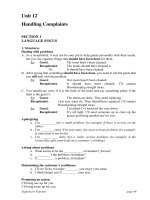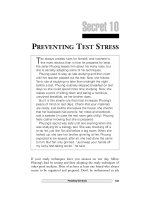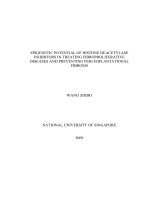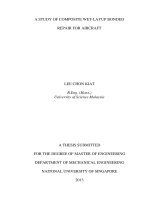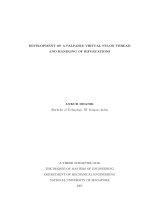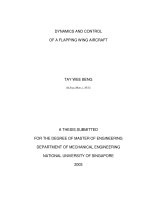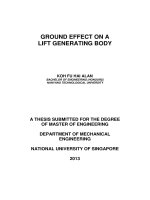Preventing aircraft ground handling delays
Bạn đang xem bản rút gọn của tài liệu. Xem và tải ngay bản đầy đủ của tài liệu tại đây (1.69 MB, 97 trang )
PREVENTING AIRCRAFT GROUND HANDLING DELAYS IN VIETNAM
AIRLINES
In Partial Fulfillment of the Requirements of the Degree of
MASTER OF BUSINESS ADMINISTRATION
In International business
By
Mr. Nguyen Le Phuong
ID: MBA03025
International University – Vietnam National University HCMC
February 2013
Preventing aircraft ground handling delays in Vietnam Airlines
PREVENTING AIRCRAFT GROUND HANDLING DELAYS IN VIETNAM
AIRLINES
In Partial Fulfillment of the Requirements of the Degree of
MASTER OF BUSINESS ADMINISTRATION
In International business
by
Mr: Nguyen Le Phuong
ID: MBA03025
International University – Vietnam National University HCMC
February 2013
Under the guidance and approval of the committee, and approved by all its members, this
thesis has been accepted in partial fulfillment of the requirements for the degree.
Approved:
..............................................
..............................................
Assoc. Prof. Ho Thanh Phong
Committee member
..............................................
..............................................
Committee member
Committee member
..............................................
..............................................
Committee member
Committee member
2
Preventing aircraft ground handling delays in Vietnam Airlines
Acknowledge
First of all, I wish to express my sincere gratitude to my supervisor Assoc. Prof. Ho
Thanh Phong for inspiring me this interesting topic and sharing his great knowledge,
priceless input and documents help during my research.
I specially want to express thankfulness to my colleagues, friend, who support,
encourage and share idea to me during the time I do the research.
Last but not least, I want to say thankful to my family, especially my mother who
always beside me and give me power to complete my dissertation.
It has been an honor to have a chance working with all the people involved during the
research period and a great learning experience for me.
With many thanks,
3
Preventing aircraft ground handling delays in Vietnam Airlines
Plagiarism Statements
I would like to declare that, apart from the acknowledge references, this thesis either
does not user language, ideas, or other original material from anyone; or has not been
previously submitted to any other educational and research programs or institutions. I fully
understand that any writings in this thesis contradicted to the above statement will
automatically lead to the rejection from the MBA program at the International University –
Vietnam National University Ho Chi Minh City.
4
Preventing aircraft ground handling delays in Vietnam Airlines
Copyright Statement
This copy of the thesis has been supplied on condition that anyone who consults it is
understood to recognize that its copyright rests with its author and that no quotation from the
thesis and on information derived from it may be published without the author’s prior
consent
© Nguyen Le Phuong/ MBA03025/ 2013
5
Preventing aircraft ground handling delays in Vietnam Airlines
Table of Contents
Table of Contents.......................................................................................................................6
Chapter one – Introduction ......................................................................................................13
1.1
Research background ................................................................................................13
1.2
Problem statement .....................................................................................................14
1.3
Research objectives ...................................................................................................15
1.4
Research structure .....................................................................................................15
Chapter two - Literature Review..............................................................................................16
2.1
Definition of Aircraft Ground Handling ...................................................................16
2.2
Aircraft Ground Handling in VNA at TSN Airport ..................................................17
2.3
Modeling of turnaround process using petri nets ......................................................19
2.4
Impact of analysis tools on aircraft turnaround processes ........................................23
2.5
Ideas to improve ground handling operations ...........................................................24
2.6
Apply theory of constraints and critical path to turnaround time .............................25
2.7
Aircraft ground handling and human factors ............................................................27
2.8
Ground handling Cost ...............................................................................................28
Conclusion............................................................................................................................30
Chapter Three - Research methodology ..................................................................................31
3.1
Research design.........................................................................................................31
3.2
Research process .......................................................................................................32
3.3
Data Collection..........................................................................................................33
3.4
Data analysis .............................................................................................................33
3.4.1
Critical path method...........................................................................................33
3.4.2
Seven basic tool of quality.................................................................................36
3.4.3
Flow chart ..........................................................................................................38
..........................................................................................................................................40
3.4.4
Fault tree analysis ..............................................................................................41
3.4.4
Descriptive statistics ..........................................................................................47
3.4.5
Multiple linear regressions.................................................................................47
3.4.6
Reliability simulation and test mode..................................................................48
Chapter 4 - Research Finding ..................................................................................................49
6
Preventing aircraft ground handling delays in Vietnam Airlines
4.1
Defects analysis.........................................................................................................49
4.1.1
‘Late cockpit crew’ defect .................................................................................49
4.1.2
‘Refueling tanker positioning late’ defect..........................................................63
4.1.3
‘Late cabin crew’ defect.....................................................................................68
4.1.4
‘Move aircraft from hangar to parking late” defect ...........................................72
4.1.5
Calculate FTA....................................................................................................77
4.2
Ground Handling Cost ..............................................................................................78
Chapter five - Research conclusion & Recommendation ........................................................79
5.1
Research conclusion..................................................................................................79
5.2
Recommendation.......................................................................................................80
5.3
Limitation ..................................................................................................................80
References................................................................................................................................81
7
Preventing aircraft ground handling delays in Vietnam Airlines
List of Figures
Figure 1: Aircraft ground handling operation in VNA ............................................................18
Figure 2: Conceptual model of the aircraft ground handling system.......................................20
Figure 3: Hierarchical graph of CPN model f turnaround process ..........................................21
Figure 4: Comparison of experiment 1 and experiment 2 simulation results ..........................22
Figure 5: Mean Aircraft Turnaround time improvem..............................................................23
Figure 6: Critical path 737-800................................................................................................26
Figure 7: Research process ......................................................................................................32
Figure 8: Critical path of turnaround ground handling for a passenger transport aircraft taking
cargo.........................................................................................................................................35
Figure 9: Fish-bone diagram for delayed aircraft ground handling .........................................36
Figure 10: Control chart of On Time Departure Flights at TSN airport ..................................37
Figure 11: Departure flight’s defects .......................................................................................38
Figure 12: Aircraf ground handling flow chart at TSN airport................................................41
Figure 13: Fault tree model for aircraft ground handling ........................................................44
Figure 14: 'Cabin cleaning late' event ......................................................................................45
Figure 15: Normal distribution for 'late cock pit crew' defects before applying solutions ......53
Figure 16: Late cockpit crew defect.........................................................................................58
Figure 17: Normal distribution for 'late cock pit crew' defects after applying solutions.........59
Figure 18: Normal distribution for 'late refueling tanker' defects before applying solutions ..65
Figure 19: Late refueling tanker truck positioning ..................................................................66
Figure 20: Normal distribution for 'late refueling tanker' defects after applying solutions .....67
Figure 21: Normal distribution for 'late cabin crew' defects before applying solutions ..........70
Figure 22: Late cabin crew defect............................................................................................71
Figure 23: Normal distribution for 'late cabin crew' defects after applying solutions .............72
Figure 24: Normal distribution for 'late cabin crew' defects before applying solutions ..........74
Figure 25: Late moving aircraft from hangar to parking .........................................................75
Figure 26: Normal distribution for 'late cabin crew' defects after applying solutions.............76
8
Preventing aircraft ground handling delays in Vietnam Airlines
List of Table
Table 1: Turnaround ground handling process design specifications for a new narrow body
turnaround ground handling concept for the 737-800 .............................................................26
Table 2: Implementation plan for a new narrow body turnaround ground handling concept
based on the 737-800 ...............................................................................................................27
Table 3: Number of Departure Flight’s defects .......................................................................43
Table 4: 'Late cockpit crew' defect's data ................................................................................51
Table 5: 'Late cockpit crew' defect with mean = 50.58 and standard deviation = 23.82 .........57
Table 6: 'Late cockpit crew' defect with mean = 20.5 and standard deviation = 8.3 ...............63
9
Preventing aircraft ground handling delays in Vietnam Airlines
List of Appendix
Appendix 1...............................................................................................................................83
Appendix 2...............................................................................................................................84
Appendix 3...............................................................................................................................86
Appendix 4...............................................................................................................................88
Appendix 5...............................................................................................................................89
Appendix 6...............................................................................................................................91
Appendix 7...............................................................................................................................93
Appendix 8...............................................................................................................................94
Appendix 9...............................................................................................................................96
10
Preventing aircraft ground handling delays in Vietnam Airlines
Glossary
VNA
Vietnam Airlines
TOC
TAN SON NHAT Operation Center
OCC
Operating Control Center
VAECO
VNA Engineering Company
VINAPCO
Vietnam Air Petrol Company
TIAGS
TSN International Airport Ground Service
VN/CX
Vietnam Catering
FCD 919
Flight Crew Divisions
SITATEX
Critical operations for airlines, ground handlers, global
distribution system, airfreight and aerospace companies
TSN
Tan Son Nhat airport
VIP
Very important person
ATC
Air traffic control
SAC
Southern Airport Corporation
SRO
Southern Region Office
11
Preventing aircraft ground handling delays in Vietnam Airlines
Abstract
Punctuality is one of the key performance indicators in the airline industry and an
important service differentiator especially for valuable high-yield customers. In addition,
improved on-time performance can help achieve significant cost savings. Airlines report
delay costs from 0.6 to up to as much as 2.9% of their operating revenues. VNA stated that
they want to convey passengers or freight from one point to another with maximum safety,
efficiency and on time performance. However, within 12.34% of delayed flights in 2011due
to aircraft ground handling (annual report’s TOC), VNA operation is not very effectively in
aircraft ground handling. The project is about aircraft ground handling process in VNA.
Aircraft ground handling is a key component of the air transport logistics supply chain as it
facilitates the mobility of cargo and people from one destination to another. Delays in
movement of cargo and passengers at the airport are costly to passengers, businesses and the
economy. Thus the project aims to build the model that analyze all aircraft ground handling
operations, look for the critical factors that effect on flight delay and find out the final effect
in flight delay if those factors are controlled. This report further describes the methodology
of how to structure the project, and a project plan with a time schedule is given.
Keywords: delay, aircraft ground handling, punctuality
12
Preventing aircraft ground handling delays in Vietnam Airlines
Chapter one – Introduction
This chapter introduces the research background, problem statement, research
objectives and built up research question to show what problem that we should be solves.
1.1
Research background
VNA was established by the Vietnam government in 1956. It was officially established
as the national flag carrier of Vietnam in 1993. Currently, VNA operates flights to 35
international destinations in Asia, Australia, Europe and the Middle East, and to 18 domestic
destinations in Vietnam. With a modern fleet of aircraft (including 6 Airbus A320s, 30
Airbus A321s, 9 A330s, and 10 Boeing 777s, 14 ATRs 72 and 2 Fokker 80s), VNA provides
service with traditional Vietnamese hospitality ensuring passengers have the best possible
introduction to the wonderful and vibrant country of Vietnam. Having recently redesigned
their business class cabin VNA is now able to provide luxury travel to compete with many of
the larger international airlines. Serving European destinations such as Paris and Frankfurt as
well as cities in America and all over Asia, and through partnerships with airlines such as
Qantas, Cathay Pacific, and Korean Airlines, VNA is making the country of Vietnam a more
accessible destination whether for a short break or a longer period of travel.
From 2010 to 2012, VNA has increased the on time percentage for departure flights at
TSN airport dramatically. On time performance means that actual arrival and departure times
must be within 15 minutes of the published schedule. Many factors can affect punctuality
performance, including aircraft ground handling, timeliness of passengers, and aircraft arrival
times on connecting flights.
According to TOC which represents for VNA at TSN airport, in 2011, there were 4477
delayed and cancelled flights upon 64012 flights operated by VNA (approximately 18.05%
of total flights). Many causes of delays are outside the responsibility of the VNA such as
13
Preventing aircraft ground handling delays in Vietnam Airlines
weather, airport authorities and air traffic control. However, some delays are controllable; for
example: ground handling, aircraft maintenance and flight or cabin crew rotation.
On top of the negative impact on customer satisfaction, delays are expensive. Direct
and indirect delay costs typically range from 0.6% to 2.0% of revenue, depending on the size
and type of operation. Thus, punctuality should rank high on top-management’s agenda and
to be a leadership challenge throughout the organization from strategy and planning all the
way to frontline operations.
1.2
Problem statement
When flights are on time, it is good for passengers and also helps the airlines' bottom
lines. The passenger’s choice of airlines may be affected by the on-time arrival experience of
passengers. The passengers may show stronger reaction (switch to other airlines) when they
realize utility losses (service level below their expectation) than when they experience utility
gains (service level above their expectation).More importantly, punctual airlines appear to be
more profitable. According to AEA (the Association of European Airlines) a top-10 carrier
performing carries $100 to $400 million in annual delay costs and for each percentage point
improvement in punctuality there is a potential profit improvement of $4 to $16 million,
depending on the size of the airlines.
In 2011, there were 3978 delayed flights upon 64012 flights operated by VNA
(approximately 12.34% of total flights) due to aircraft ground handling (annual report’s
TOC).VNA always focuses on Direct Operating Cost (DOC), because DOC include ground
handling costs, depreciation, interest, insurance, fuel costs, crew costs, maintenance costs,
landing fees and navigation fees. For airlines, flights delay mean increase turnaround time
and DOC as well. In VNA, the major source of flight delays at TSN airport is aircraft ground
handling, usually by causing mistakes or wrong activities.
14
Preventing aircraft ground handling delays in Vietnam Airlines
Within this research, it is focused on ground handling services analyzing to prevent the
flight delays.
1.3
Research objectives
The objectives of the research project are to:
To identify factors that cause delay in aircraft ground handling.
To evaluate effect of wrong activities in aircraft ground handling.
To develop a model for integrating all aircraft ground handling malfunction.
To control flight delay and reduce Direct Operating Cost in flights.
1.4
Research structure
This thesis comprises 5 chapters as below:
Chapter 1: Introduction
This chapter introduces the research background, problem statement, research
objectives and built up research question to show what problem that we should be solves.
Chapter 2: Literature review
This chapter introduces the conceptual framework aircraft ground handling in VNA at
TSN airport and some key theories concept support for this study.
Chapter 3: Research methodology
This chapter focuses on the methodology for this study in terms of research design,
research process, data analysis and the statistical method that was used for this research
Chapter 4: Research Finding
This chapter support data analysis and present outcome of research result.
15
Preventing aircraft ground handling delays in Vietnam Airlines
Chapter 5: Research conclusion & Recommendation
This chapter proposes some conclusions and as a result of finding and significant of
study, researcher recommends some solution to solve the problem mentioned.
Chapter two - Literature Review
This chapter introduces the conceptual framework aircraft ground handling in VNA at
TSN airport and some key theories concept support for this study.
2.1
Definition of Aircraft Ground Handling
After aircraft is parked and chocks are put, turnaround process begins. The turnaround
of an aircraft comprises the sequence of ground operations required to service the aircraft
between two flights, from the time the chocks (rubber blocks to prevent aircraft from
moving) are put in front of the wheels after it lands, to the time the chocks are removed and
the aircraft is ready to leave. Many different organizations are involved in the turnaround
process making it a complex and often inefficient operation.
There are a number of key tasks carried out during and aircraft turnaround such as:
loading and unloading passengers and baggage, safety and security checks, catering
replenishment, cleaning and the completion of essential post and pre-flight administration. It
should be noted that the servicing arrangements and turnaround tasks vary for different
aircraft and different operators. The turnaround processes are typically shared between
several organizations and it is essential that they work together effectively to deliver the
optimal turnaround. This is further complicated when the aircraft is being handled at a
remote airport by third party ground handling organizations.
16
Preventing aircraft ground handling delays in Vietnam Airlines
2.2
Aircraft Ground Handling in VNA at TSN Airport
Ground handling help to address service requirements of an airliner between the time it
arrives at a terminal gate and the time it departs on its next flight. Speed, efficiency, and
accuracy are very important in ground handling services in order to minimize the turnaround
time. Aircraft ground handling includes services on the ramp such as:
a.
Guiding the aircraft into and out of the parking position.
b.
Air-bridge positioning/removal.
c.
Towing with pushback tractors.
d.
Lavatory drainage.
e.
Water cartage.
f.
Air conditioning.
g.
Air starts units.
h.
Luggage handling.
i.
Gate checked luggage.
j.
Air cargo handling.
k.
Catering trucks.
l.
Refueling tanker truck.
m.
Ground power.
n.
Passenger stairs.
o.
Wheelchair lifts.
17
Preventing aircraft ground handling delays in Vietnam Airlines
These services are belonged to VNA members such as: TIAGS, VAECO, VN/CX, FCD
919, Flight Attendant and VINAPCO. TOC is able to verify what flight is at what gate
through SAC, the time the flight arrived and the time the flight is scheduled to depart via
OCC. Hence, TOC forward this flight information to each VNA member by SITATEX and
monitor the progress of each flight.
Figure 1: Aircraft ground handling operation in VNA
VNA Operations said that it costs them too much money for every minute that a flight
is delayed. It is important to note that, for an airline, the “value” of delay is not just its effect
on an individual airframe but its effect on the operating schedule. Passengers do not go out to
the airport to fly on a specific airplane. They go to catch the one o’clock flight to Da Nang
18
Preventing aircraft ground handling delays in Vietnam Airlines
which is promised in the airline’s published schedule. Hence, controlling wrong activities in
aircraft ground handling also control flight delay, minimize operating costs and build trust in
passengers. The aim of this study is to identify and investigate ideas to improve aircraft
ground handling and control flight delay in VNA.
2.3
Modeling of turnaround process using petri nets
When aircraft turnaround is finished and aircraft is ready to leave according to
schedule, aircraft pilot contacts ATC and waits for the clearance to begin push-back
procedure. Figure 2 below illustrates the conceptual model of the system.
19
Preventing aircraft ground handling delays in Vietnam Airlines
Figure 2: Conceptual model of the aircraft ground handling system
20
Preventing aircraft ground handling delays in Vietnam Airlines
According to Anna Norin (2008), it is found that one of the things making the logistics
at an airport complex is the large number of actors involved, as well as the many activities
that are sensitive to time. One very time sensitive process, where almost all of the actors are
involved, is the turn-around process, which makes it a key process for airport logistics. With
some adjustment, it will be possible to use the optimization algorithm developed for
scheduling de-icing trucks, even for the other activities in turnaround process. Implementing
optimized schedules for all the activities will give an even more complete picture of airport
logistics, showing how all actors and processes are linked to each other and resulting in
minimum aircraft delay.
There were many different models of the aircraft turnaround process that have been
developed in order to investigate its sensitivity to changes of available resources, aircraft
arrival delays, different gate assignment strategies. The specific class of Petri Nets used is the
Hierarchical Stochastic Colored Timed Petri Nets (CPN). Petri Nets are a graphical and
mathematical modeling tool.
Figure 3: Hierarchical graph of CPN model f turnaround process
The highest hierarchical level called Entry/Exit which models: aircraft arrival
(ENTER), parking, entering turnaround process queue, push back and departure (EXIT). The
two subnet of hierarchy level 2, START is used for data input (schedule arrival time, aircraft
type, and schedule departure time); Turnaround process, models all activities of aircraft
21
Preventing aircraft ground handling delays in Vietnam Airlines
turnaround process and it is connected with two hierarchies level 3 subnets: Service and
Bellyhold unloading, which models ground service and cargo/baggage handling activities.
Experiments differ in terms of gate-assignment strategy. The first experiment gates
were dedicated to aircraft according to gate assignment plan, while in the second were
automatically assigned during aircraft arrival. Scenario 2 assumes lack or failure of ground
handling equipment. Scenario 3 assumes aircraft arrival time as a random variable with
uniform distribution (schedule time +/- 5 minutes). Scenario 4 assumes variable passenger
deplaning and boarding time such as late transfer passengers.
Through analysis it has been clear that gate-assignment strategy where gates are
dedicated to aircrafts according to gate assignment plan leads to additional delays when
operations are perturbed. Departure delay as well as turnaround process is always smaller
when using automatic assignment strategy than using strict gate assignment strategy. This is
a great importance, especially at hub airports where most of the passengers are transfer
passengers whose inbound flights delays will cause delays of outbound flights. Moreover, the
change of gate assignment close to aircraft arrival will usually result in a longer turnaround
(need to transfer outbound baggage, cargo and passengers ...).
Figure 4: Comparison of experiment 1 and experiment 2 simulation results
22
Preventing aircraft ground handling delays in Vietnam Airlines
2.4
Impact of analysis tools on aircraft turnaround processes
The tools, which include single-minute exchange of dies, lean manufacturing processes
and critical path have been examined and applied to aircraft turnarounds.
Single-Minute Exchange of Die (SMED) is one of the many lean production methods
for reducing waste in a manufacturing process. It is a concept that focuses on improving
machine setups: internal setup (tasks that can only be performed when a machine has
stopped) and external setup (tasks that can be carried out while the machine is in operation).
Applied to aircraft turnaround time, where an aircraft turnaround is seen as a setup operation
(Tasks carried out while the plane is on the ground are the internal setup and external setup
refers to activities which may be carried out before the plane lands).
Lean manufacturing is a philosophy of production that emphasizes the minimization of
the amount of resource (including time) used in the various activities of the enterprise. Lean
manufacturing involves identifying and eliminating non value adding activities and focuses
on the start-to-end values streams rather than the idea of optimizing individual departments
in isolation. Waste is a term frequently associated with lean manufacturing and the focus
should be on preventing waste rather than eliminating it. Thus, the principle of lean
manufacturing can be applied to aircraft turnaround.
Approach to mean turnaround time improvement by using Identification Technologies
(ID) as well as the SMED and Critical Path consists of three main steps:
Figure 5: Mean Aircraft Turnaround time improvement
23
Preventing aircraft ground handling delays in Vietnam Airlines
Step 1: Get an overview of the turnaround operations, the timings of these operations,
the technology and information currently used. Using the information collected, a Gantt chart
and the critical path for the ideal/minimum turnaround was produced for each airline.
Step 2: Critical path processes; more in-depth understanding of the processes. This was
achieved by walking through the processes, watching them in real time, speaking to cabin
and flight deck crew, ground and operations staff.
Step 3: Areas for the application of ID technologies; Areas where critical path
processes could be improved and areas where the time of these processes could be reduced
by using ID technologies were identified.
Numbers of areas within the critical path of the turnaround were identified (Boarding,
Cleaning/Security, Technical delays). Technical delays and late loading cause a significant
disturbance to the turnaround. These tasks are typically carried out by partner organizations
and require timely, accurate information to be effective. ID technologies show that the
information systems and business processes for sharing this information between partners are
essential.
2.5
Ideas to improve ground handling operations
According to Gomez, F. &Scholz, D. (2009), Speed, efficiency and accuracy are
important in ground handling operations in order to minimize turnaround time and ground
handling costs. Improvement to ground handling operation always aim at reducing
turnaround time and ground handling costs, if improvements to ground handling operations
also reduce Direct Operating Costs (interest, insurance, fuel costs, maintenance costs, crew
costs, landing fees and navigation fees).
24
Preventing aircraft ground handling delays in Vietnam Airlines
The turnaround times are dramatically decreased with the automatic pushback system,
the airstairs and the installation of a main third door for passengers in the airplane.
Automatic pushback system avoid the tractor for the pushback operation -> the ground
handling costs could be reduced because ground handling fees can be reduced and additional
time and fuel could be saved.
Airstairs decrease ground turnaround times and save deboarding/boarding operation
cost. With airstairs no ground services are necessary.
Third door saves a lot of time in boarding/deboarding operations. This time-saving has
a great importance in the low cost airlines’ turnaround process; where boarding and
deboarding take part on the critical path.
All the modifications to ground handling costs may have a positive influence on the
DOC of the aircraft. In the best-case scenario, the benefit in DOC per flight could rise to
3.45% if all the compatible modifications to ground handling operation are taken into
account simultaneously.
2.6
Apply theory of constraints and critical path to turnaround time
The Theory of constraints and critical path analysis showed that in the normal flight,
the duration of cabin activities determines the total turnaround time. It also means the critical
paths lie in the cabin.
25

